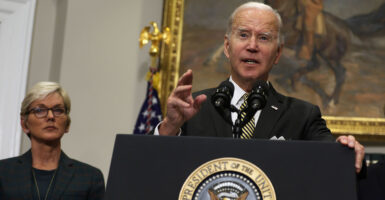A “green energy” project in rural North Dakota is yet another such initiative that misses the mark.
Despite the Energy Department’s admission that the Tundra Project would emit three times more carbon dioxide than it captures, a department grant worth up to $350 million is going to this proposed carbon capture and storage endeavor. The venture is backed by two American companies, Minnkota and Kiewit, as well as Canada’s TC Energy and Japan’s Mitsubishi Heavy Industries.
But Project Tundra, planned for North Dakota’s Oliver County, presents a climate problem of its own. The project could emit more greenhouse gases than it stores because of the energy it takes to transport the carbon dioxide.
“There is an expected 3.23 kg of CO2 emitted per kg of CO2 stored,” the Energy Department’s environmental assessment of the project states.
Under Project Tundra, a lignite coal station would be modified to fulfill unachievable mandates for net-zero carbon emissions. The process would employ “point source carbon capture,” in which carbon emissions are captured immediately after production.
Once the coal is used to produce energy, Project Tundra would employ the Fluor Corp.’s Econamine PG Plus system, which captures CO2 and sulfur hexafluoride using a fluoride-amine solvent, reheats the solvent, isolates the captured gases, and pumps the gases for storage one mile below ground.
However, according to the Institute for Energy Economic and Financial Analysis, Fluor’s system was tested on a slipstream 10 times smaller than the retrofitted North Dakotan plant. Upscaling the technology often leads to unanticipated problems, as previous tests of such facilities have shown.
Project Tundra would emit more greenhouse gases than it saves, but some carbon capture and storage facilities both have reduced emissions and provided marginal economic benefits.
For example, Petra Nova in Texas received $190 million in Energy Department grants to reinject captured carbon into oil reserves to store the gases and flush out the hydrocarbons. From 2017 to 2020, Petra Nova exchanged 3.9 million short tons of captured CO2 with 4.2 million barrels of oil while reducing total emissions by 33%.
Although carbon capture and storage facilities such as Petra Nova provide some natural resources to offset the retrofitting cost, Project Tundra would rely solely on government grants and federal “45Q” tax credits, which provide $85 per ton of CO2 permanently stored underground.
The initial estimated cost in 2022 of $1 billion for Project Tundra has risen to $1.9 billion. Despite the increased cost, it received authorization for a $150 million loan from the North Dakota Industrial Commission last July through the state’s Clean Sustainable Energy Authority. In December, Project Tundra secured the additional $350 million from the Energy Department.
Even with the infusion of more taxpayer funds, there is substantial worry that Minnkota customers also would have to finance this new carbon capture and storage facility. In some states, climate initiatives force citizens to pay almost 20% more for green energy projects at a time of unprecedented inflation.
Despite these increased costs, Project Tundra’s carbon capture goals actually have decreased. Originally, it was supposed to reduce carbon emissions by 95%. Today, the goals have decreased to a 74% reduction, a drop of 21 percentage points before construction of the facility has begun.
This decline relates to a troubling trend that appears when examining major carbon capture and storage projects. According to the National Energy Technology Library, 175 such CCS facilities are planned or operational in the U.S.
Among 13 flagship CCS facilities capturing roughly 55% of total carbon captured worldwide, only a few have been sustainable even with carbon taxes or subsidies. Others either failed or are performing 20% to 50% below original target rates due to unscalable capture technology.
These same technological hurdles contribute to lower carbon capture goals for North Dakota’s Project Tundra, which looks to be yet another underperforming carbon capture and storage venture.
Yet, the federal government continues to throw taxpayer dollars at failed climate initiatives while simultaneously attacking sound energy projects.
Investors in Project Tundra will decide whether to move forward a little later in the year. Foreign and domestic firms are certainly free to invest in Project Tundra and other such pilot technology.
However, distributing more than half a billion in taxpayer dollars to a carbon capture and storage venture that emits three times the amount of carbon it sequesters is completely unwarranted anytime—especially when Americans are suffering through a period of unprecedented inflation caused by government spending.
Have an opinion about this article? To sound off, please email letters@DailySignal.com, and we’ll consider publishing your edited remarks in our regular “We Hear You” feature. Remember to include the URL or headline of the article plus your name and town and/or state.

























